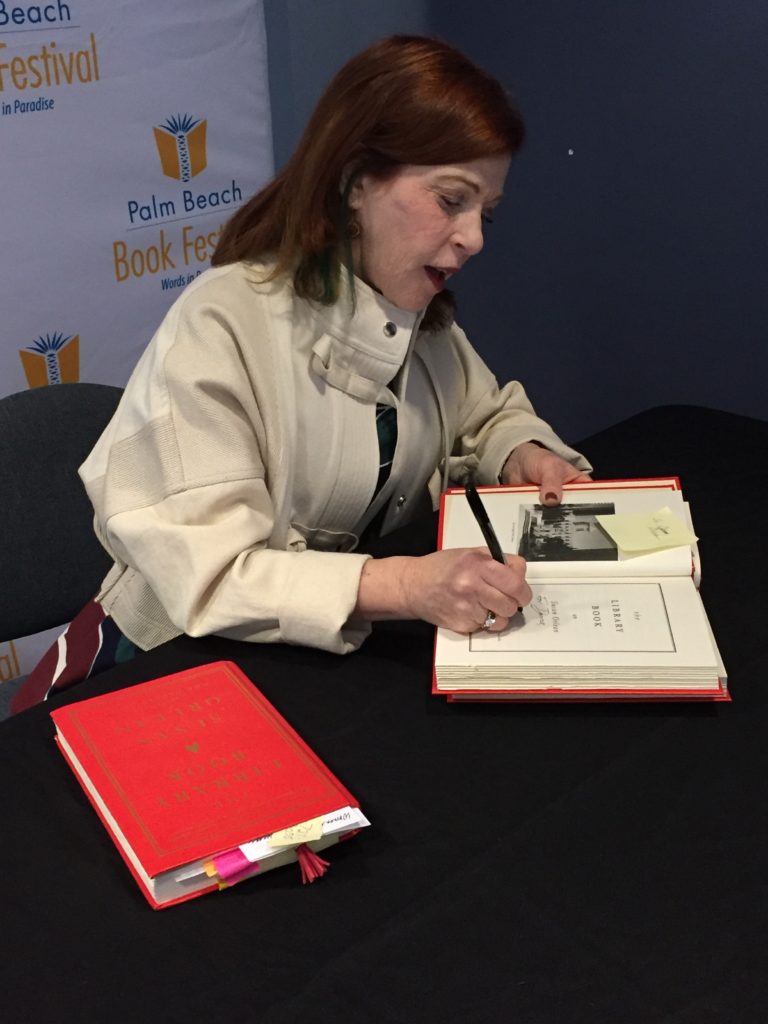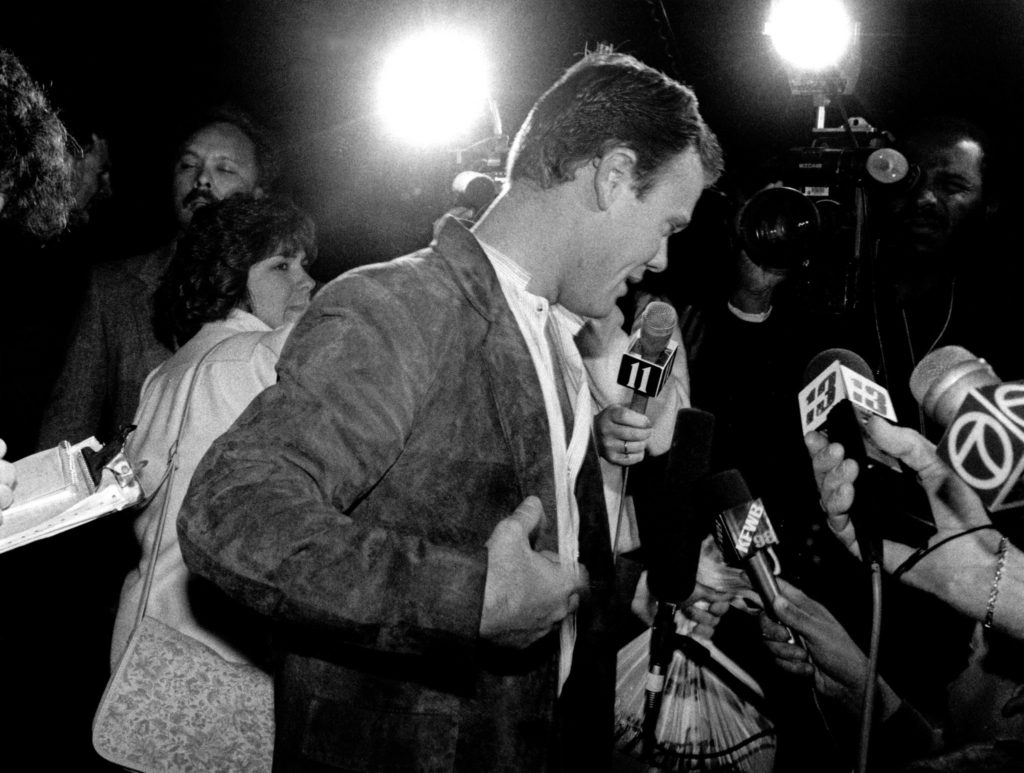 The Library Book in the headline does not refer to any old, non-specific book checked out of a library. It is the title of an actual hardcover by Susan Orlean, better known, perhaps, for being the author of The Orchid Thief on which the Nicholas Cage movie, Adaptation, was based.
The Library Book in the headline does not refer to any old, non-specific book checked out of a library. It is the title of an actual hardcover by Susan Orlean, better known, perhaps, for being the author of The Orchid Thief on which the Nicholas Cage movie, Adaptation, was based.
The book, which is the non-fiction account of the 1986 fire that destroyed the Los Angeles Central Public Library is also partly the history of that library. The fire was the largest library fire ever in the U.S. It caused $22 million worth of damage. None of the content was insured.
Not One Single Dull Sentence

When Orlean appeared at the Palm Beach Book Festival last month, she said she was aware that “any book beginning in the 1890’s and containing the word “library” was not going to turn people on.”
Along with almost everybody else in the audience, I laughed. That was before I read the book. Had I previously read it, I would have had to stand up to reassure Orlean that not only were her fears misplaced, but that The Library Book does not contain a single dull chapter, a single dull paragraph, nor even a single dull sentence.
It is quite simply a magnificent gem of a book that is part thriller (who was the arsonist? was it really the colorful, loser-actor wannabe who had a penchant for putting himself at the centre of any newsworthy drama?); part history (of the library and its librarians); and part action documentary describing in the most vivid detail the spread of the fire through the library.
Path of Destruction

Take these few abbreviated segments, for example, starting with firefighters reaching the Fiction Department: “There they saw smoke threading along a shelf of books that started with a Robert Coover novel and ended with one by John Fowles. The smoke began to coil upward, drifting through the open grating of the shelves like a ghost […] At first, the smoke in the Fiction stacks was as pale as onionskin. Then it deepened to dove gray. Then it turned black.
“The heat built. The temperature reached 451 degrees and the books began smoldering. Their covers burst like popcorn […]The fire flashed through Fiction. The cookbooks roasted. The fire scrambled to the sixth tier and then to the seventh […]It poked around looking for more air and fuel […] Wind gusts filled the vacuum made by the fire. Hot air saturated the walls. The floor began to fracture[…] The temperature reached 900 degrees, and the stacks’ steel shelves brightened from gray to white […] soon glistening and nearly molten, they glowed cherry red. Then they twisted and slumped, pitching their books into the fire.”
Voluminous Research
 Reads like fiction doesn’t it? But none of it came from Orlean’s imagination. The route taken by the fire and the destruction it wreaked were pieced together by the author from the voluminous research she undertook. This included studying the log kept by the fire department.
Reads like fiction doesn’t it? But none of it came from Orlean’s imagination. The route taken by the fire and the destruction it wreaked were pieced together by the author from the voluminous research she undertook. This included studying the log kept by the fire department.
“It’s a minute-by-minute log which is very dry and technical about which hose is attached to which fire hydrant. It was an invaluable resource,” said Orlean, providing a picture of “how the firefighters attacked the fire and how it moved.”
She also interviewed firefighters who were there on the day for their anecdotal versions, and she researched the “detailed log” belonging to the insurance company which also provided an exact description of what was going on at the time.”
Fascinating History
 For Orlean, the 1986 fire was an “epic event that resonated emotionally,” but she realized that she couldn’t make the fire resonate for a wider audience without telling the history of the library. In all, Orlean spent four years on research and reporting before she started writing. And, it shows.
For Orlean, the 1986 fire was an “epic event that resonated emotionally,” but she realized that she couldn’t make the fire resonate for a wider audience without telling the history of the library. In all, Orlean spent four years on research and reporting before she started writing. And, it shows.
Who knew that libraries and librarians could be so fascinating? Orlean describes the first public library in the city as a “reading room in a dance hall.” Later, a new library was welcomed, but the “space was cramped and inadequate … a menace to life” at a time when “influenza, smallpox and typhus were rampant.”
She also delves into the characters who were its first appointed chief librarians : there’s a Mary Foy who, shockingly for the time (1880) was not only a woman but just 18 years old, and whose father had to walk her home from work every day.
Then, there was Charles Lummis, a character you’d have to say came straight from the pages of novel about an eccentric adventurer, but who in real life upon being offered his first job in L.A. (as a reporter) walked the three thousand miles from Ohio to his new home. He wrote and published articles along the way and therefore arrived in L.A. already as a full blown celebrity.
Chief Suspect

Orlean is a master of painting vivid character portraits on the printed page. Her descriptions of Harry Peak, the chief suspect in the arson that destroyed the library, are pieced together from hours of interviews with Harry’s friends and family.
Although it has never been determined if Peak was the arsonist (he was arrested but not indicted) Orlean melds his story with the story of the city. She writes: “Harry Peak’s life in Los Angeles was at least luminous with possibility. It was in the chemical makeup of Los Angeles; possibility was an element, like oxygen.”
Her book is also the story of a community that came together to Save The Books. Any book lover reading the account of the destruction of 400,000 books and damage to 700,000 more (none of which were insured; only the building was) will be brought to tears by the facts. But he/she will also tear up at the account of how movie producers, stars, corporate executives and thousands of regular people in the city came together to raise $10 million to replace the books.
Book-Burning by Bad People
Woven through the three major parts of The Library Book are snippets of information that are enthralling, riveting and horrifying in parts. In a section on the insidious history of book-burning through the centuries, Orlean has a particularly throat-clenching description of book-burnings by the Nazi Party in pre-war Germany. Specifically, the “Feuerspruche” (Fire Incantations) were a pet project of war criminal Joseph Goebbels, in whose opinion, “burning Jewish books was an ideal form of bloodless torture.”
At the Book Festival, Orlean spoke about this part of her book: “It’s rare that good people burn books,” she said. “Usually, the next step is they burn people.”
She keeps us riveted, taking the reader from the horror of historical book-burnings to snippets like the one about author Ray Bradbury, who, after graduating from high school, could not afford to go to college. He spent almost every day of the next 13 years in the Library, reading his way through each department. Bradbury later wrote the sci-fi/horror bestseller Fahrenheit 451 (the temperature at which paper burns.)
Snippets

Or, maybe, you’re interested in what kind of books have been stolen from the library and why and by whom? For example, on the day Elvis Presley died, someone checked out all of the library’s Elvis records and never returned them.
Movie studios are also “major book-pinching culprits,” writes Orlean. “Rather than simply checking out books they needed for their research — and thus having to abide by the due date — studios sometimes dispatched assistants to the library to steal them.”
Or, there’s this thought-provoking snippet that, in Senegal, when people speak politely of someone passing away, they say “his/her library has burned.”
I found this information particularly poignant when Orleans explained it as follows: “When I first heard the phrase, I didn’t understand it, but over time I came to realize it was perfect. Our minds and souls contain volumes inscribed by our experiences and emotions; each individual’s consciousness is a collection of memories we’ve catalogued and stored inside us, a private library of a life lived.”
B/W Photo Credit: Boris Yaro, Los Angeles Times
Joanna, you hooked me with the excerpt of the fire in the library. I agree that is some beautifully descriptive writing. Pulled me right into the scene. I’ll be reading this one
I know that as a former firefighter you’ll love this one, Greg.